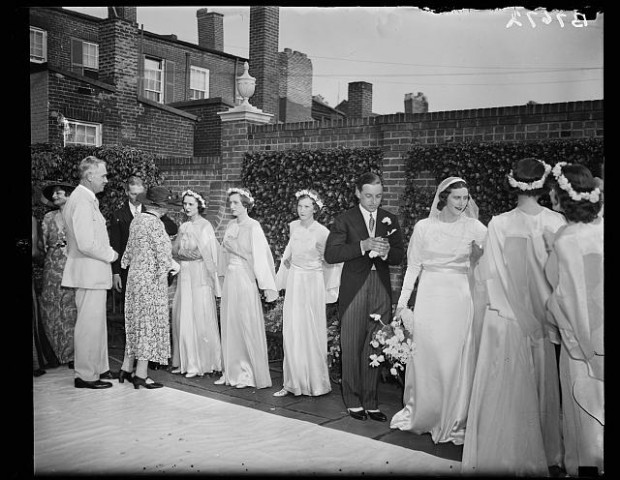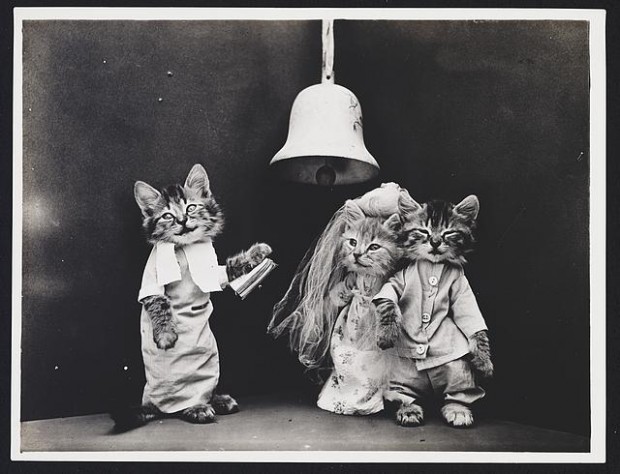 The beginning of June marks full-blown wedding seasons, which means if you work in photography, interior design, event planning, catering, letter-pressing, or almost any other creative pursuit, you may be weathering the impact of a time of year that’s both extremely lucrative and also completely exhausting. Even if you’re just a creative hobbyist, odds are, you know someone who’s getting ready to walk down the aisle at some point in the next three months — it’s just that time of year. So, for Throwback Thursday, we decided to take a look back at some vintage wedding photography.
The beginning of June marks full-blown wedding seasons, which means if you work in photography, interior design, event planning, catering, letter-pressing, or almost any other creative pursuit, you may be weathering the impact of a time of year that’s both extremely lucrative and also completely exhausting. Even if you’re just a creative hobbyist, odds are, you know someone who’s getting ready to walk down the aisle at some point in the next three months — it’s just that time of year. So, for Throwback Thursday, we decided to take a look back at some vintage wedding photography.
Now a multi-million dollar business, wedding photography was once something of a formality — because the equipment was so much larger and less mobile than it is now, wedding photos were either taken in a studio before the actual event, or at the site of the wedding, but not on the day of. They were also largely uncreative, mostly comprised of family portraits and the odd cake-cutting shot. It wasn’t until WWII that on-site wedding photography of the event itself even became commonplace, and not until the 1970s did candids at weddings really come into style.
As you’re packing up your multiple tripods and dozens of lights and lenses this summer, think back to the old days of vintage wedding photography, when even a reliable film camera would have been a luxury. And, of course, revel in the fact that you don’t have to try to make some of these dresses look flattering.
This bride was captured in August 14, 1943 by Jack Sportswood. This style of dress-flaring was huge for…oh, decades. Image via Florida Memory, the State Archives of Florida.
Here’s another one buy Jack Spottswood from Florida Memory, circa 1941. Apparently, wedding photography has been a way for photographers to pay the bills for decades.
According to the archive, the Spottswoods were “commercial photographers [who] were kept on retainer by the Seaboard Railroad and the Atlantic Coast Line Railroad, and they did a considerable amount of work for real estate agencies and for insurance companies photographing accident scenes. As a result, the collection contains numerous images of Jacksonville-area street scenes, businesses, churches, hotels, theaters, and trains, as well as studio portraits and wedding photographs.”
The Harris & Ewing Collection at the Library of Congress contains tens of thousands of glass negatives, many of which include portraits of notable people. It also includes a LOT of weddings, like the above three. Interestingly, H&E seemed to spend more time shooting on-location than other photography outlets, which suggests that most of the subjects of the photos — which are presented by the LOC with next to no detail or description — were probably high-profile individuals or couples. The size of the wedding party in the third photo would suggest the same.
 Maria Roderiques and Josefino Lopes Cabral were wed in 1928 in Nantucket.
Maria Roderiques and Josefino Lopes Cabral were wed in 1928 in Nantucket.
This is an example of the kind of studio photography that many couples opted for at the time, which documented the marriage itself more than the wedding day.
However, some couples — often those with a little more spending money, though that wasn’t always the case — did opt for wedding photos that look a little more familiar to us today, let the next photo in the set, from the same year and area.
Arline Wilma Preston and Clark Wallace Bishop were married in 1928. Image via the Nantucket Historical Association. Nantucket became a popular wedding destination in the 1920s and 30s, which means many photographers from the city had to truck their equipment out to an island to shoot images like this one.
This 1978 bride, whose name is Debra Roby, is pictured wearing the wedding dress worn by Arline Wilma Preston when she married Clark Wallace Bishop in 1928 — which is the photo above!
According to the comments from the Nantucket Historical Association, Roby was the granddaughter or Preston.
And now, for something completely different, here’s an image of a Chippewa wedding ceremony, circa the late 1870s. Courtesy of the Whitney & Zimmerman gallery, this image was taken by Charles Zimmerman, a prominent Minnesota photographers of the era. The image comes to us via the Library of Congress.
Candids and the kinds of images we take to be standard now — like this “getting ready” shot of a bride and her bridesmaids — became popular in the late 1960s and early 1970s. Also popular at the time: White eyeshadow. Image via the Nantucket Historical Association.
Presented without comment, via the Library of Congress.











